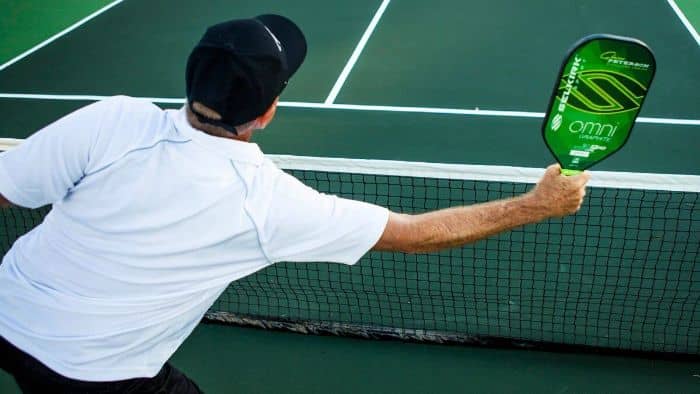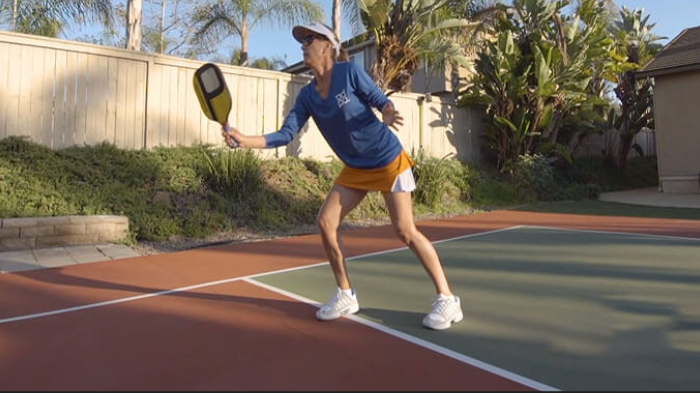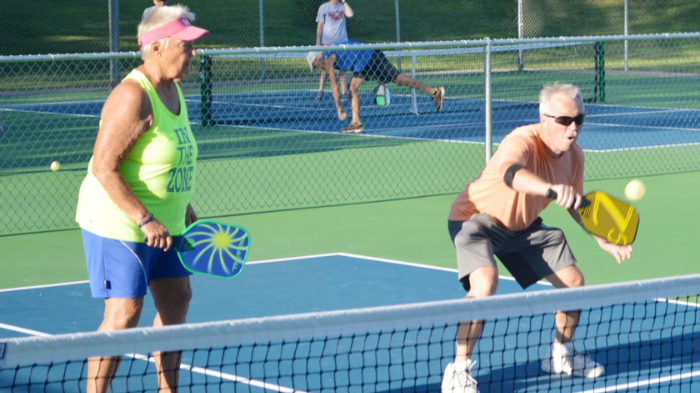In the game of pickleball, it is essential for players to familiarize themselves with the specific rules to prevent common faults in pickleball, which results in players losing their points or being disqualified from the game. Among the most prevalent mistakes in pickleball is foot fault. A clear understanding of foot faults is vital for upholding fair play and fostering a competitive atmosphere in pickleball.

In this blog post, we are going to explore in detail what is a foot fault in pickleball and the types of pickleball foot faults. We are also going to explain in detail the consequences that a player might suffer after making a foot fault in pickleball and how to avoid foot faults while playing pickleball. Read this blog, be aware of foot faults in pickleball, its consequences, and tips for avoiding those faults in the game.
What Is a Foot Fault in the Game of Pickleball?
In the game of pickleball, a foot fault occurs when a player steps into the non-volley zone, also known as the kitchen, during or before making a volley shot or pickleball third shot drop. The kitchen is a seven-foot area on both sides of the net, extending from the net to the non-volley zone line.
According to the official rules of pickleball, players are not allowed to enter the kitchen and hit a volley shot unless the ball bounces in the kitchen area first or the opponent hits the ball into the kitchen. Stepping into the kitchen and hitting a volley shot without meeting these conditions results in a foot fault.
When a foot fault is called, the opposing team is awarded a point, and the serve usually switches to the other team. It is important for players to be mindful of their position on the court and avoid stepping into the kitchen while attempting to volley shots to maintain fair play.
There are two types of foot faults in pickleball:
A Foot Fault At The Baseline
A foot fault at the baseline happens when the server fails to keep both feet behind the baseline during the serve. According to the official pickleball rules, the server’s feet must be completely behind the baseline and should not touch or cross over the baseline until the serve is made.
If the server commits a foot fault at the baseline, the serve is considered a fault, and the server gets another attempt. However, if the server commits consecutive foot faults at the baseline, resulting in two faults in a row, the serve is considered a fault, and the opposing team earns a point and the serve.
A Foot Fault At The Kitchen Line
A kitchen foot fault in pickleball occurs when a player steps into the non-volley zone (kitchen) while hitting a volley shot. The non-volley zone, also known as the kitchen, covers an area of seven feet on both sides of the net. It extends from the net to the line that determines the boundary of the non-volley zone.

During a volley, players are not allowed to step into the kitchen and hit the ball unless the ball bounces in the kitchen or the opponent’s shot lands in the kitchen. If a player steps into the kitchen and hits a volley shot without meeting these conditions, it results in a foot fault. When a foot fault at the kitchen line occurs, the opposing team is awarded a point, and the serve usually switches to the other team.
It is crucial for players to familiarize themselves with the foot fault rules and ensure that their feet are properly positioned during serves and volleys. This is essential to uphold fair play, prevent penalties, and maintain a level playing field.
What Will Happen After a Player Has Done Foot Fault in Pickleball?
In pickleball, a foot fault occurs when a player steps on or beyond the baseline or sideline during the serve. If a player commits a foot fault, the following outcomes may occur:
Fault Is Called: The fault is called by the referee or an opponent who notices the foot fault. The point is immediately awarded to the opposing team, resulting in a side-out or a point loss, depending on the game situation.
Warning: In some informal or friendly games, the first foot fault may result in a warning rather than an immediate loss of points. The warning serves as a reminder to the player to correct their foot positioning and avoid future faults.
Re-Serve: If the foot fault is noticed before the serve has been completed, the server will be allowed to re-serve without any penalty or loss of points. This allows the server to rectify their foot positioning and make a legal serve.
It is important to note that the specific consequences of a foot fault may vary depending on the tournament, league, or local rules being followed. Therefore, it is advisable to familiarize yourself with the specific rules and regulations of the pickleball event or organization you are participating in to understand the exact repercussions of a foot fault.
How to Avoid a Foot Fault in Pickleball?
To avoid committing a foot fault in pickleball, it is important to pay attention to your foot positioning during the serve. Here’s a detailed explanation of how to avoid a foot fault:
Understand The Court Boundaries: Familiarize yourself with the court dimensions and boundaries in pickleball. The court is divided into the right and left service courts by the centerline, and each service court has a baseline and sideline. Make sure you know the specific dimensions of the court you’re playing on.
Position Yourself Correctly: Stand behind the baseline and between the sidelines when preparing to serve. Both feet should be completely behind the baseline, ensuring that no part of your foot touches or goes beyond the baseline or sideline.
Watch Your Feet: During the serve, keep your eyes on your feet to ensure they remain in the proper position. Pay attention to your footwork and maintain a stable stance.
Practice Your Footwork: Develop good footwork habits by practicing proper positioning during your serves. Invest some time in practicing and getting comfortable with how you position your feet on the pickleball court. By doing this, you can train your muscles to remember the correct foot placement. Consider taking a step back from the baseline or angling your feet strategically to reduce the chances of unintentionally crossing the line and committing a foot fault.

Maintain Balance And Control: When serving in pickleball, it is important to be mindful of your movements. Avoid making sudden lunges or leaning too far forward, as these actions can lead to unintentional foot faults. Stay aware of your body positioning and strive for balance and control to minimize the risk of committing a foot fault while serving.
Seek Feedback: If you’re unsure about your foot positioning or have received warnings regarding foot faults in the past, seek feedback from a coach, referee, or experienced player. They can observe your serve and provide guidance on improving your footwork technique.
Stay Focused: Pay attention to the game and your foot placement throughout the match. Maintain focus on the court boundaries and be conscious of your position relative to the lines.
Remember, rules and interpretations may vary depending on the specific event or organization you’re playing under, so it is essential to review the rules and guidelines provided to ensure you adhere to the appropriate regulations and avoid foot faults.
Read About: wrist pain pickleball and what celebrities play pickleball?
FAQs
The consequences of a foot fault in a pickleball tournament can differ depending on the tournament’s specific rules and regulations. Typically, a foot fault leads to the opposing team receiving the point immediately, which can result in a side out or a deduction of points for the team that committed the foot fault.
Yes, even in non-competitive matches, foot faults can be called. While the consequences might be less strict, it is still important to abide by the rules to maintain fairness and good sportsmanship.
The penalties associated with multiple foot faults vary depending on the rules being followed. Different regulations may entail warnings or a progression of consequences for repeated foot faults, including point deductions or disqualification. To grasp the penalties for multiple foot faults, it is essential to examine the rules of the particular event or organization.
Generally, foot faults are not subject to challenges or disputes. The call of a foot fault is typically made by the referee or an opponent who observes the fault during gameplay. It is important to respect and abide by the decision of the officials or opponents in such cases.
Yes, a foot fault in pickleball can occur if your foot slips accidentally. Regardless of intent, any violation of the foot fault rule is considered a fault. It is important to make an effort to maintain proper foot positioning to avoid foot faults, even if a slip occurs. The leniency given for accidental slips may vary based on the rules and level of competition.
Conclusion
Understanding what constitutes a foot fault in pickleball is crucial for players to adhere to the rules of the game. You must be aware of the effects of foot faults in pickleball. By avoiding foot faults, players can ensure fair play and maintain a competitive environment.
If you position yourself correctly, understand about boundaries of the pickleball court, practice your footwork, take feedback from your pickleball coach or any experienced pickleball players, ensure that your legs are in the proper position, focus on your game, and maintain your balance and control while playing pickleball, you will be able to avoid a foot fault in pickleball. After writing this blog, we suggest you to follow the rules of the pickleball game and avoid foot faults in the game.



